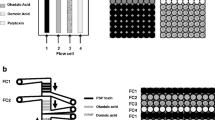Abstract
A stationary liquid-phase lab-on-a-chip (SLP-LOC), in which magnetic particles are used as a solid phase, has been previously reported as a novel platform for immunoassay methods. The SLP-LOC had a simple structure with two chambers connected by a narrow channel. The assay was performed by transporting the particles from one chamber to the next while the liquid phases were in a stationary state. However, each chamber was frequently contaminated by other chamber materials because of the small volume of the channel. Consequently, in this work, we have developed a three-chamber SLP-LOC (3C-LOC) featuring an additional chamber containing a buffered washing solution positioned between the existing two chambers and connected by channels. The dimensions of the 3C-LOC were optimized to fit into a standard spectrophotometer cuvette holder, allowing the direct measurement of absorbance. The 3C-LOC exhibited improved washing efficiency, reliability, and sensitivity in an assay of standard saxitoxin samples. Furthermore, the method was used to effectively determine whether paralytic shellfish toxin (PST) levels in shellfish samples exceeded regulatory limits. The results of this study indicate that the 3C-LOC could provide a simple and rapid method to monitor PSTs in the field.
Similar content being viewed by others
References
Wiese, M., D’Agostino, P.M., Mihali, T.K., Moffitt, M.C. & Neilan, B.A. Neurotoxic alkaloids: saxitoxin and its analogs. Mar. Drugs 8, 2185–2211 (2010).
Isbister, G.K. & Kiernan, M.C. Neurotoxic marine poisoning. Lancet Neurol. 4, 219–228 (2005).
Hollingworth, T. & Wekell, M.M. Paralytic shellfish poison biological method. Final action. in Official Methods of Analysis, 15th ed. (ed. K. Hellrich), AOAC International, Rockville, USA. pp. 881–882 (1990)
Lawrence, J.F., Wong, B. & Ménard, C. Determination of decarbamoylsaxitoxin and its analogues in shellfish by prechromatographic oxidation and liquid chromatography with fluorescence detection. J. AOAC Int. 79, 1111–1115 (1996).
Van de Riet, J.M. et al. Liquid chromatographic postcolumn oxidation method for analysis of paralytic shellfish toxins in mussels, clams, scallops, and oysters: single-laboratory validation. J. AOAC Int. 92, 1690–1704 (2009).
Lawrence, J.F. Niedzwiadek, B. & Ménard, C. Quantitative determination of paralytic shellfish poisoning toxins in shellfish using prechromatographic oxidation and liquid chromatography with fluorescence detection: collaborative study. J. AOAC Int. 88, 1714–1732 (2005).
Huang, X., Hsu, K.H. & Chu, F.S. Direct competitive enzyme-linked immunosorbent assay for saxitoxin and neosaxitoxin. J. Agric. Food Chem. 44, 1029–1035 (1996).
Usleber, E., Dietrich, R., Bürk, C., Schneider, E. & Märtlbauer, E. Immunoassay methods for paralytic shellfish poisoning toxins. J. AOAC Int. 84, 1649–1656 (2001).
Kawatsu, K., Hamano, Y., Sugiyama, A., Hashizume, K. & Noguchi, T. Development and application of an enzyme immunoassay based on a monoclonal antibody against gonyautoxin components of paralytic shellfish poisoning toxins. J. Food Prot. 65, 1304–1308 (2002).
Micheli, L. et al. Production of antibodies and development of highly sensitive formats of enzyme immunoassay for saxitoxin analysis. Anal. Bioanal. Chem. 373, 678–684 (2002).
Hara, Y., Dong, J. & Ueda, H. Open-sandwich immunoassay for sensitive and broad-range detection of a shellfish toxin gonyautoxin. Anal. Chim. Acta 793, 107–113 (2013).
Kawatsu, K., Kanki, M., Harada, T. & Kumeda, Y. A highly rapid and simple competitive enzyme-linked immunosorbent assay for monitoring paralytic shellfish poisoning toxins in shellfish. Food Chem. 162, 94–98 (2014).
Fonfría, E.S. et al. Paralytic shellfish poisoning detection by surface plasmon resonance-based biosensors in shellfish matrixes. Anal. Chem. 79, 6303–6311 (2007).
van den Top, H.J. et al. Surface plasmon resonance biosensor screening method for paralytic shellfish poisoning toxins: a pilot interlaboratory study. Anal. Chem. 83, 4206–4213 (2011).
Tang, Y. et al. A sensitive immunosorbent bio-barcode assay combining PCR with icELISA for detection of gonyautoxin 2/3. Anal. Chim. Acta 657, 210–214 (2010).
Fraga, M. et al. Multidetection of paralytic, diarrheic, and amnesic shellfish toxins by an inhibition immunoassay using a microsphere-flow cytometry system. Anal. Chem. 85, 7794–7802 (2013).
Fraga, M. et al. Multi-detection method for five common microalgal toxins based on the use of microspheres coupled to a flow-cytometry system. Anal. Chim. Acta 850, 57–64 (2014).
Szkola, A., Campbell, K., Elliott, C.T., Niessner, R. & Seidel, M. Automated, high performance, flow-through chemiluminescence microarray for the multiplexed detection of phycotoxins. Anal. Chim. Acta 787, 211–218 (2013).
Szkola, A. et al. Rapid and simultaneous detection of ricin, staphylococcal enterotoxin B and saxitoxin by chemiluminescence-based microarray immunoassay. Analyst 139, 5885–5892 (2014).
Jellett, J.F., Roberts, R.L., Laycock, M.V., Quilliam, M.A. & Barrett, R.E. Detection of paralytic shellfish poisoning (PSP) toxins in shellfish tissue using MIST Alert, a new rapid test, in parallel with the regulatory AOAC mouse bioassay. Toxicon 40, 1407–1425 (2002).
Laycock, M.V., Donovan, M.A. & Easy, D.J. Sensitivity of lateral flow tests to mixtures of saxitoxins and applications to shellfish and phytoplankton monitoring. Toxicon 55, 597–605 (2010).
Posthuma-Trumpie, G.A., Korf, J. & van Amerongen, A. Lateral flow (immuno)assay: its strengths, weaknesses, opportunities and threats. A literature survey. Anal. Bioanal. Chem. 393, 569–582 (2009).
Kim, M.H. & Choi, S.J. Immunoassay of paralytic shellfish toxins by moving magnetic particles in a stationary liquid-phase lab-on-a-chip. Biosens. Bioelectron. 66, 136–140 (2015).
Oh, K.W. & Ahn, C.H. A review of microvalves. J. Micromech. Microeng. 16, R13–R39 (2006).
Murakami, R., Yamamoto, K. & Noguchi, T. Difference in PSP composition among various parts of surf clam. J. Food Hyg. Soc. Japan 40, 55–61 (1999).
Yakes, B.J., Prezioso, S.M. & DeGrasse, S.L. Developing improved immunoassays for paralytic shellfish toxins: the need for multiple, superior antibodies. Talanta 99, 668–676 (2012).
Author information
Authors and Affiliations
Corresponding author
Rights and permissions
About this article
Cite this article
Yu, E., Choi, SJ. Development of an improved stationary liquid-phase lab-on-a-chip for the field monitoring of paralytic shellfish toxins. BioChip J 11, 30–38 (2017). https://doi.org/10.1007/s13206-016-1105-8
Received:
Accepted:
Published:
Issue Date:
DOI: https://doi.org/10.1007/s13206-016-1105-8




